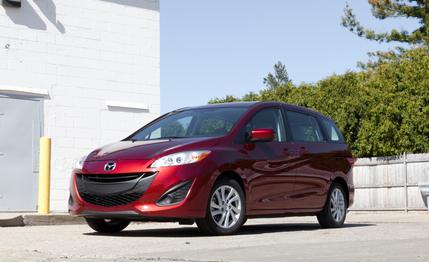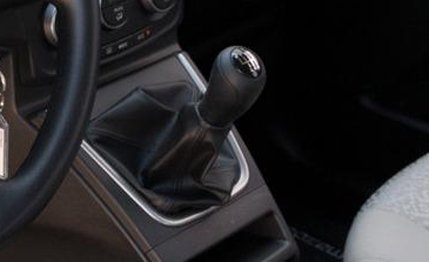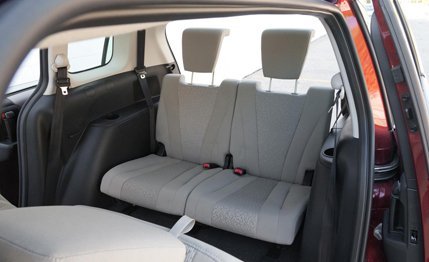
 Short Take Road Test
Short Take Road Test
The stick-shifted Mazda 5 tested here isn’t dripping in evil black paint, it’s not especially powerful, and it doesn’t turn asphalt into pudding with its tremendous power. We still feel justified in calling it Lord Vader’s van, though, as long as we’re speaking Dutch, in which vader simply means “father.” What we mean is that the Mazda 5 with a six-speed manual transmission is the ultimate dad van.
More Power, More Ratios, More Refinement
A manual transmission goes a long way to ease the sting of what is, simply put, a dorky family vehicle. But dorks and nondorks alike will find much to appreciate about the 5. Although the 2.5-liter four’s 157 hp and 163 lb-ft are something to brag about only to friends who are still piddling around in Lancia Appias, when paired with the six-speed manual transmission, they proved enough for an 8.3-second run to 60 mph. That’s a significant improvement of 0.7 second over the time we got with an autobox-equipped 5.


Pulling off that 8.3-second sprint required an abusive launch that netted a bit of torque steer (surprising from a vehicle with only 163 lb-ft) and an immoderate amount of wheelspin. In driving with fewer clutch dumps, however, takeoffs are a breeze, although we did wish for more feel through the left pedal. Like the clutches in our recently departed long-term Mazda 3 and, to a lesser extent, our Mazda 2, the takeup in the 5 is vague and numb, making it too easy to overrev the engine. On the plus side, the shifter’s action is slicker than 1954, and we appreciated the addition of a sixth cog to the gearbox. Although the last-gen Mazda 5 offered a row-your-own transmission, it was limited to five forward ratios.


There’s more to recommend the 5’s driving experience. The suspension is compliant and comfortable, the smooth ride more reminiscent of the 6 sedan’s than that of the occasionally stiff 3 with which the 5 shares its underpinnings. The steering is precise—it certainly is more direct and provides more feel than you’d find in most small three-row crossovers or in a bigger van—and the 5 feels remarkably neutral, despite an unimpressive 0.78 g on our skidpad. Make no mistake, the 5 is bested by the 3 for smiles per mile, but it is way more gratifying than something with sliding doors has a right to be.
On the road, our enthusiasm for a mini-minivan with a stick resulted in zealous use of the gas pedal, which held our observed fuel economy to 22 mpg. That’s at the bottom of the 21 mpg city/28 highway EPA estimates for the 5 and one fewer mpg than we saw with the automatic-equipped 5.
A Van for Minimalists
As minivans transitioned from 1980s suburban zeitgeist to four-wheeled punch lines, everyone—even manufacturers—realized there’s nothing sexy about a box. So vans have been designed for the past decade to sell based on reason: Successful sellers like the Honda Odyssey and Chrysler/Dodge twins are gargantuan caverns. They reward spelunking families with flipping, folding, sliding seats, Big Brother’s telescreens, and cubbies galore. But the Mazda 5 eschews the kitchen-sink philosophy, instead offering a smaller package with fewer gadgets.
A third row of seats is present, but it’s for in-a-pinch accommodations only. Legroom is nonexistent in the way back, the bottom cushion is mounted on the floor, and the headrest comprises most of the backrest as well. For the love of good joint health, put no one but your neighbor’s kids back there. Similarly, upfront storage bins are limited, and the two second-row passengers have to make do with a small console. That’s not to say the 5 feels like a stripped-out vehicle, but those expecting a plethora of bins in which to ditch empty Capri Sun pouches will be disappointed.


Because few folks actually buy Mazda 5s with manual transmissions, the company limits the stick’s availability to the entry-level Sport trim. This means the seats are cloth and the steering wheel is rubbery plastic. Also conspicuously absent from the options sheet are a sunroof, Bluetooth connectivity, iPod integration, a USB jack, a trip computer, and xenon headlights. As a result of the slim features list and short menu of extras, the entry-level 5 is actually cheaper than the least-expensive five-door Mazda 3. To its $19,990 base price, the van we tested featured a stunning $50 rear bumper guard, making it a steal at $20,040.
To get into a full-size van like the Dodge Grand Caravan, shoppers have to pony up another $5000 or so. For the money, they get more space, much more power, and more features. But you won’t find one thing on the options list for any other sliding-door vehicle in the U.S.—the 5’s manual transmission. Dads, rejoice.